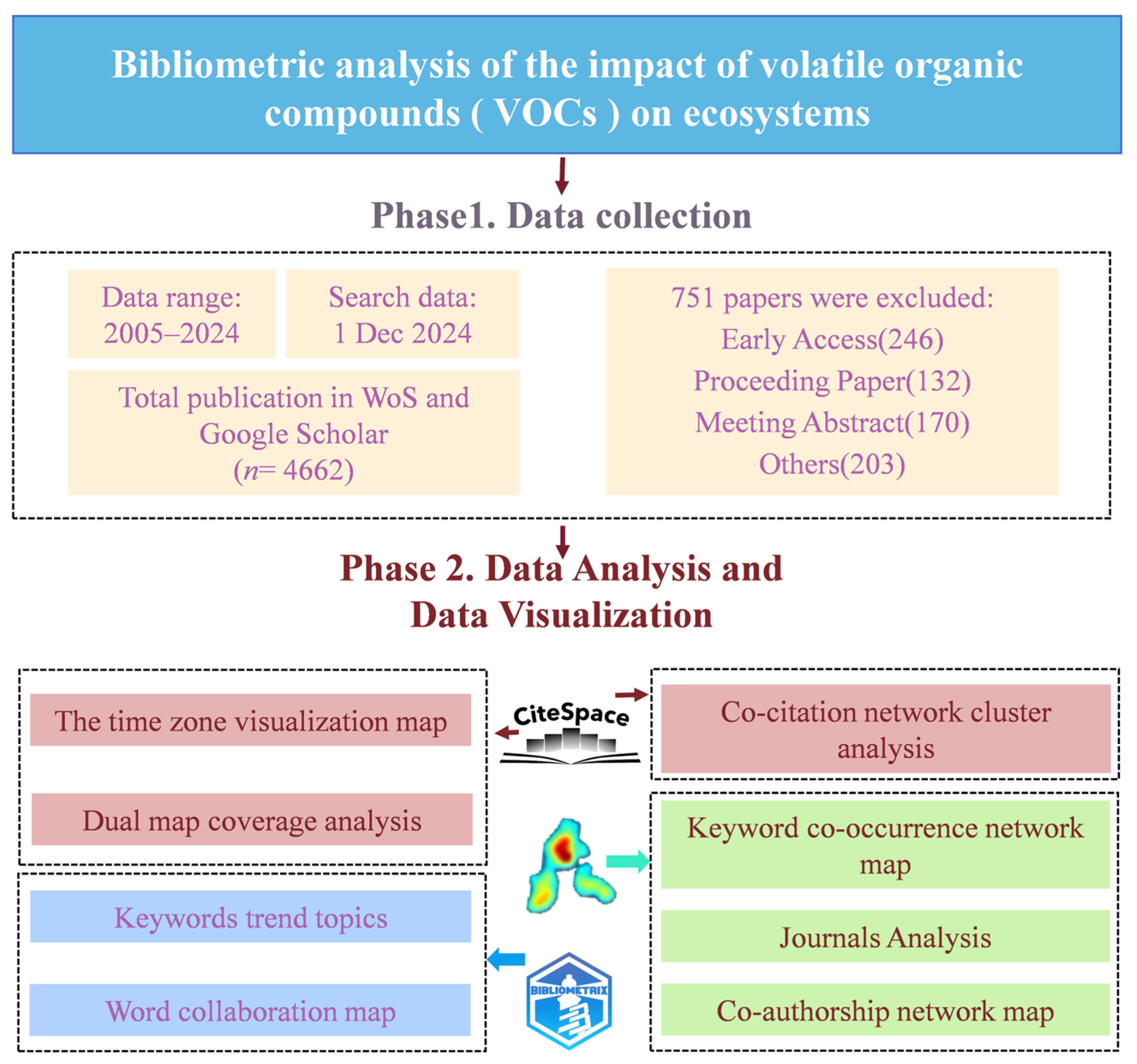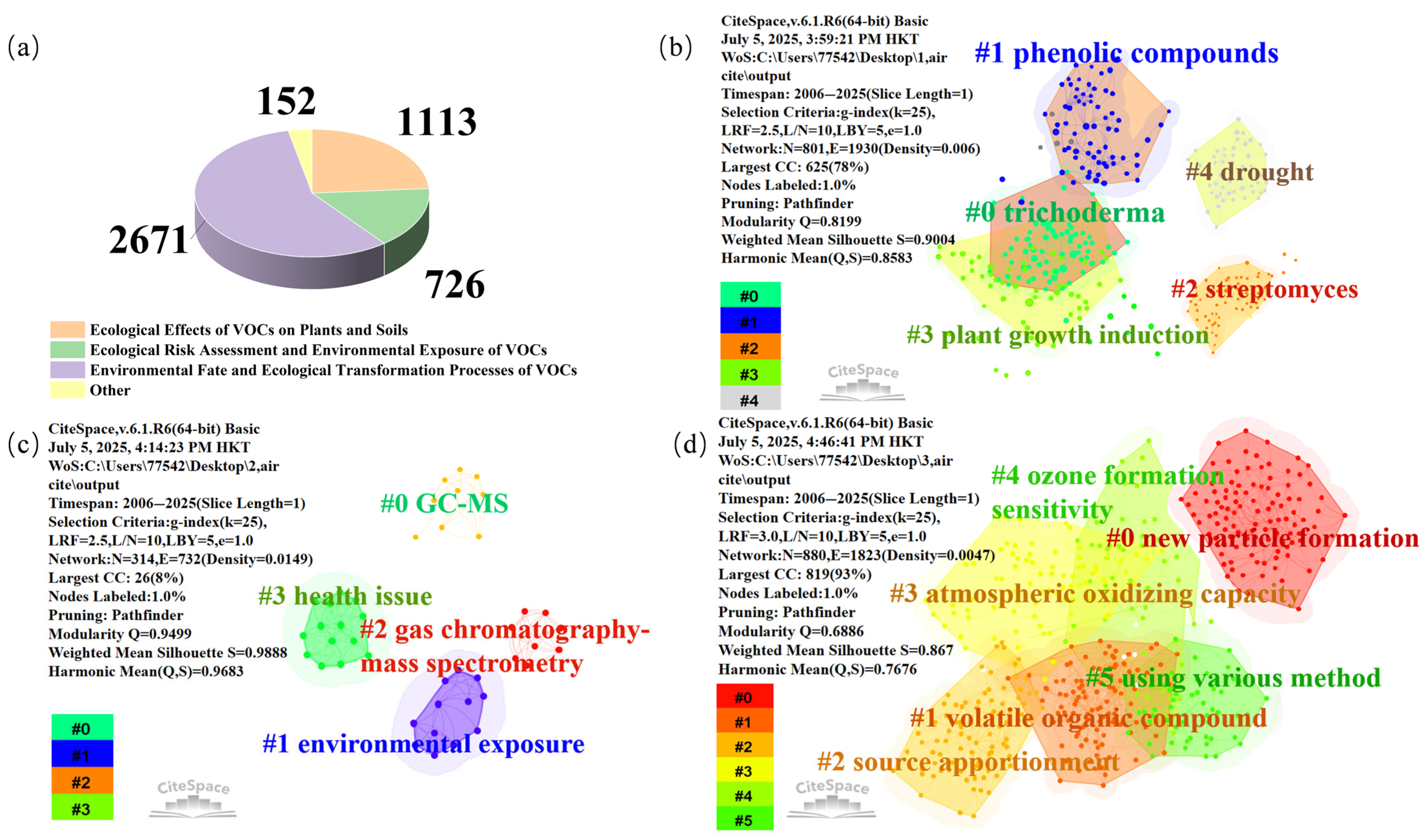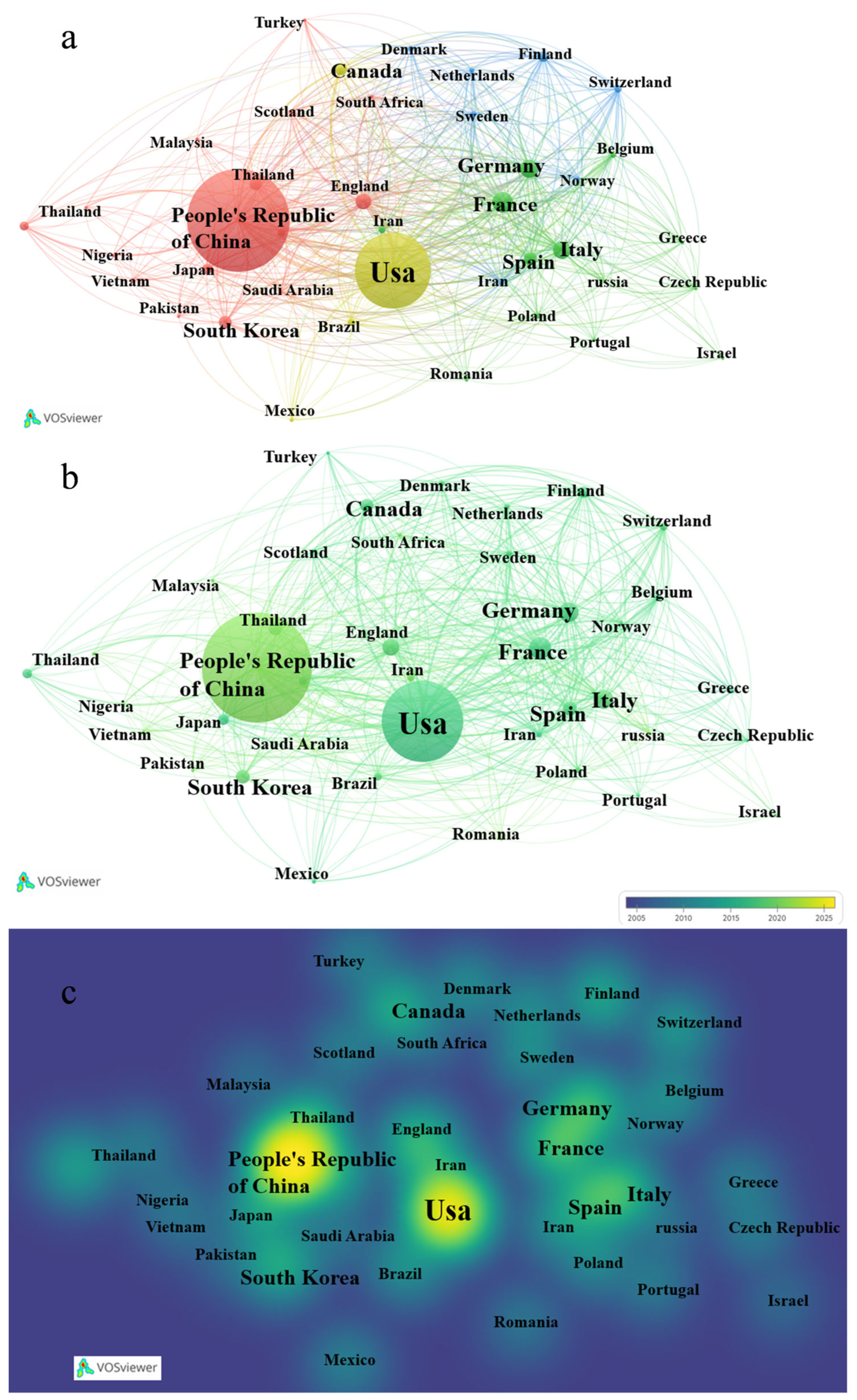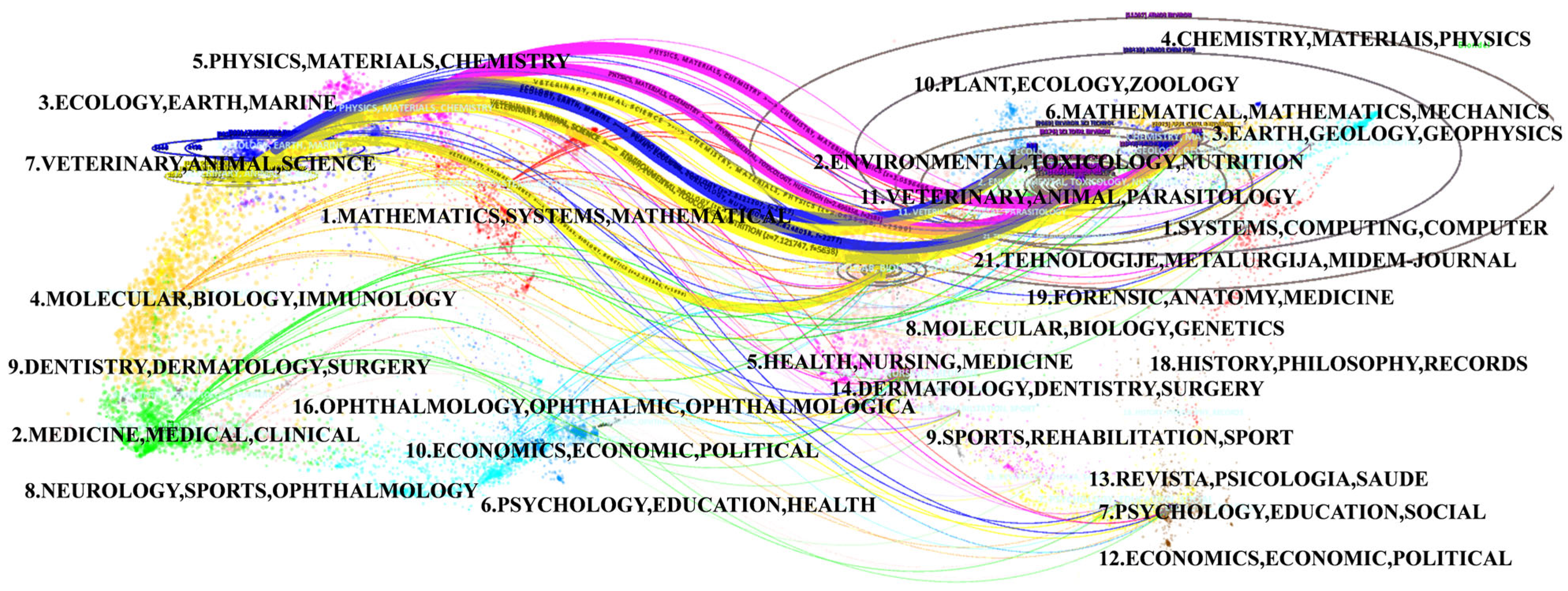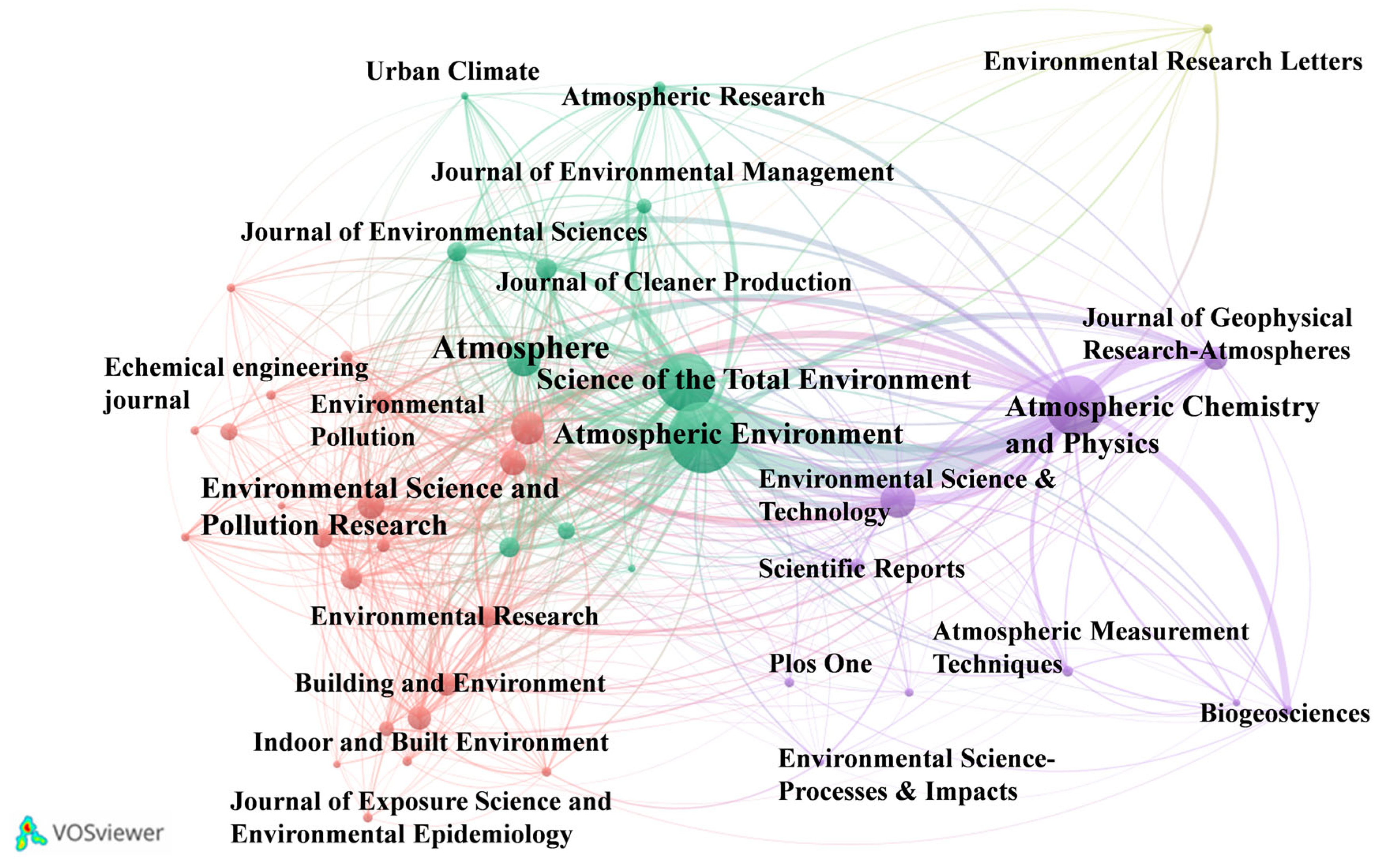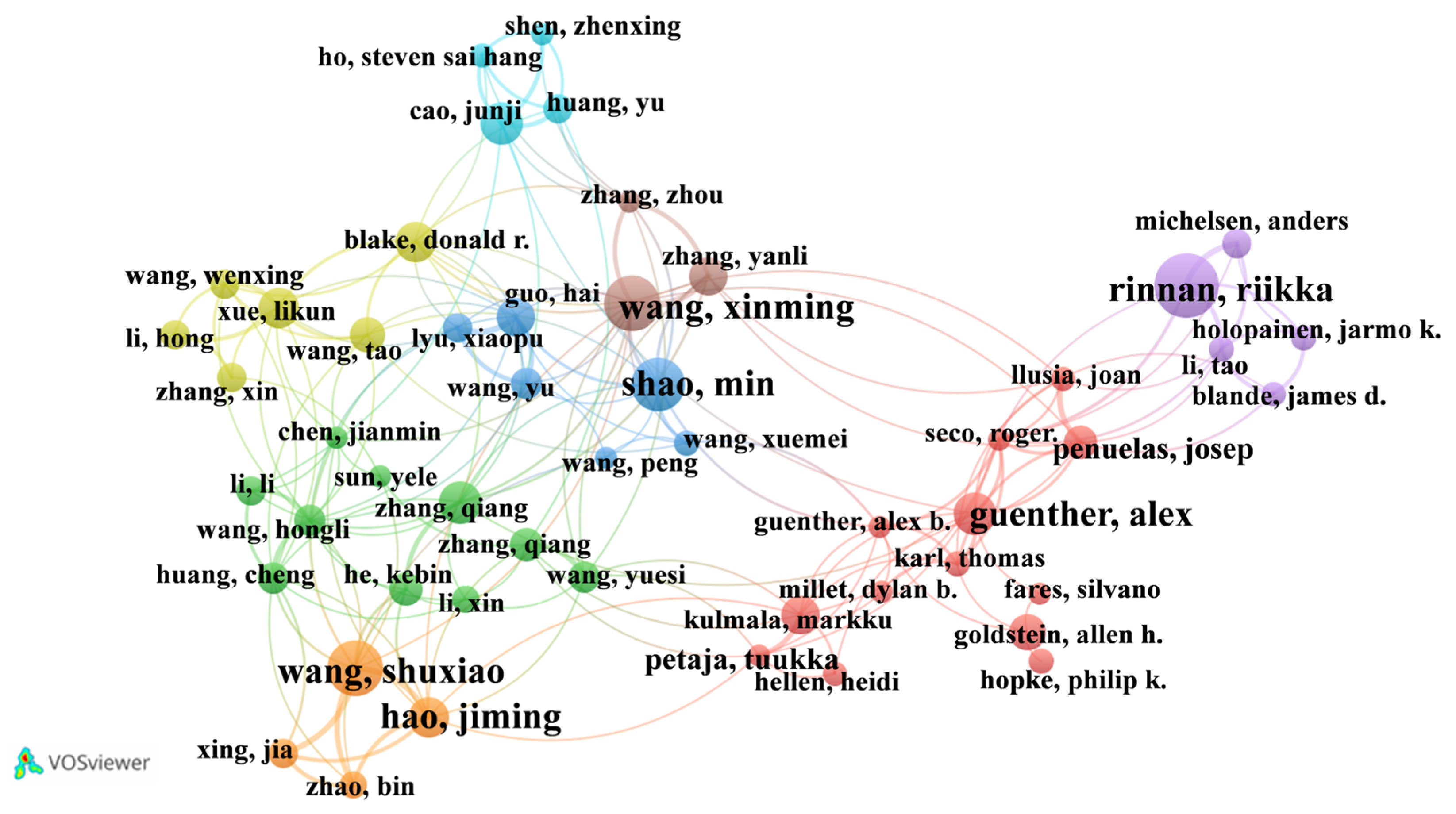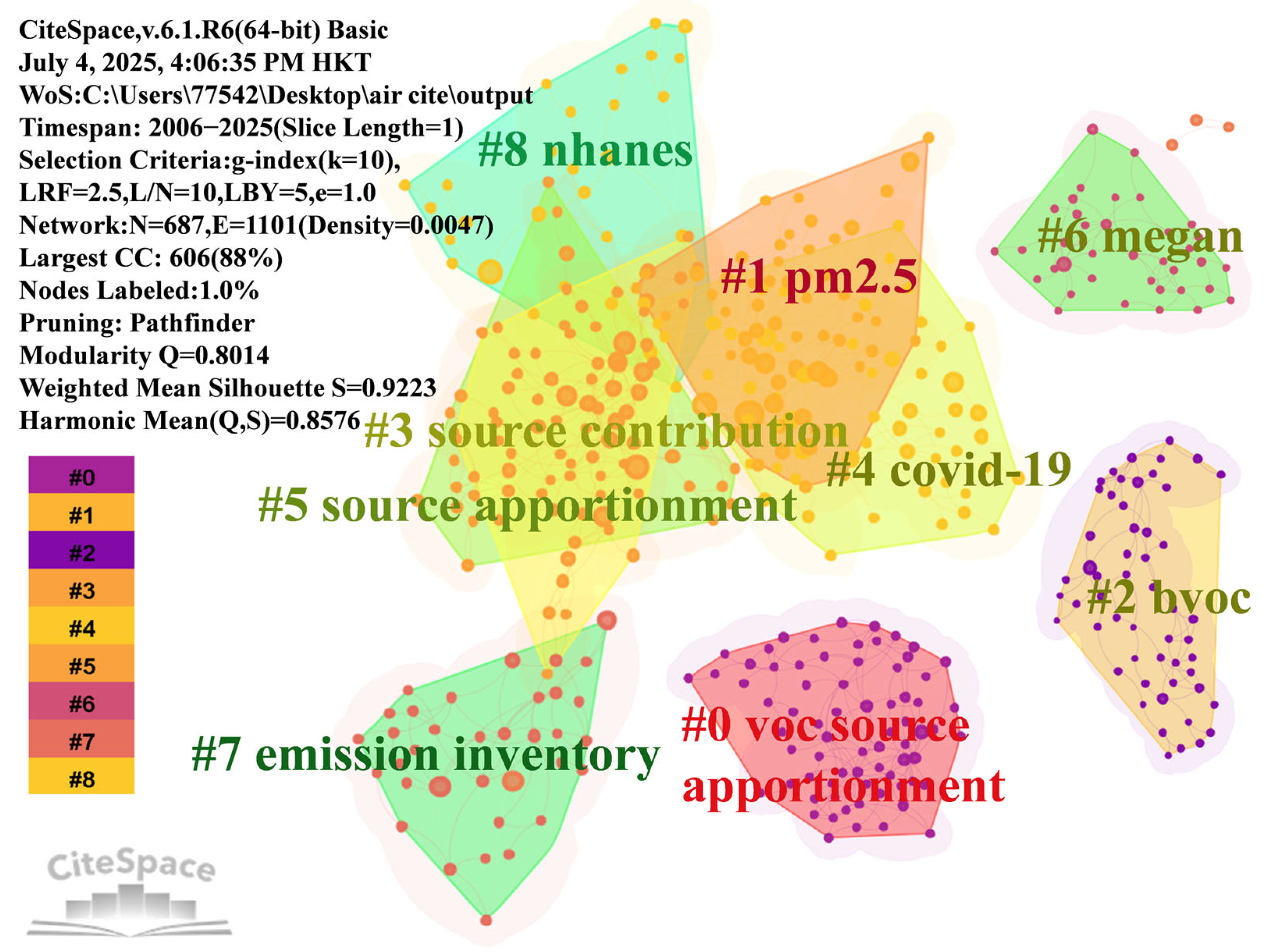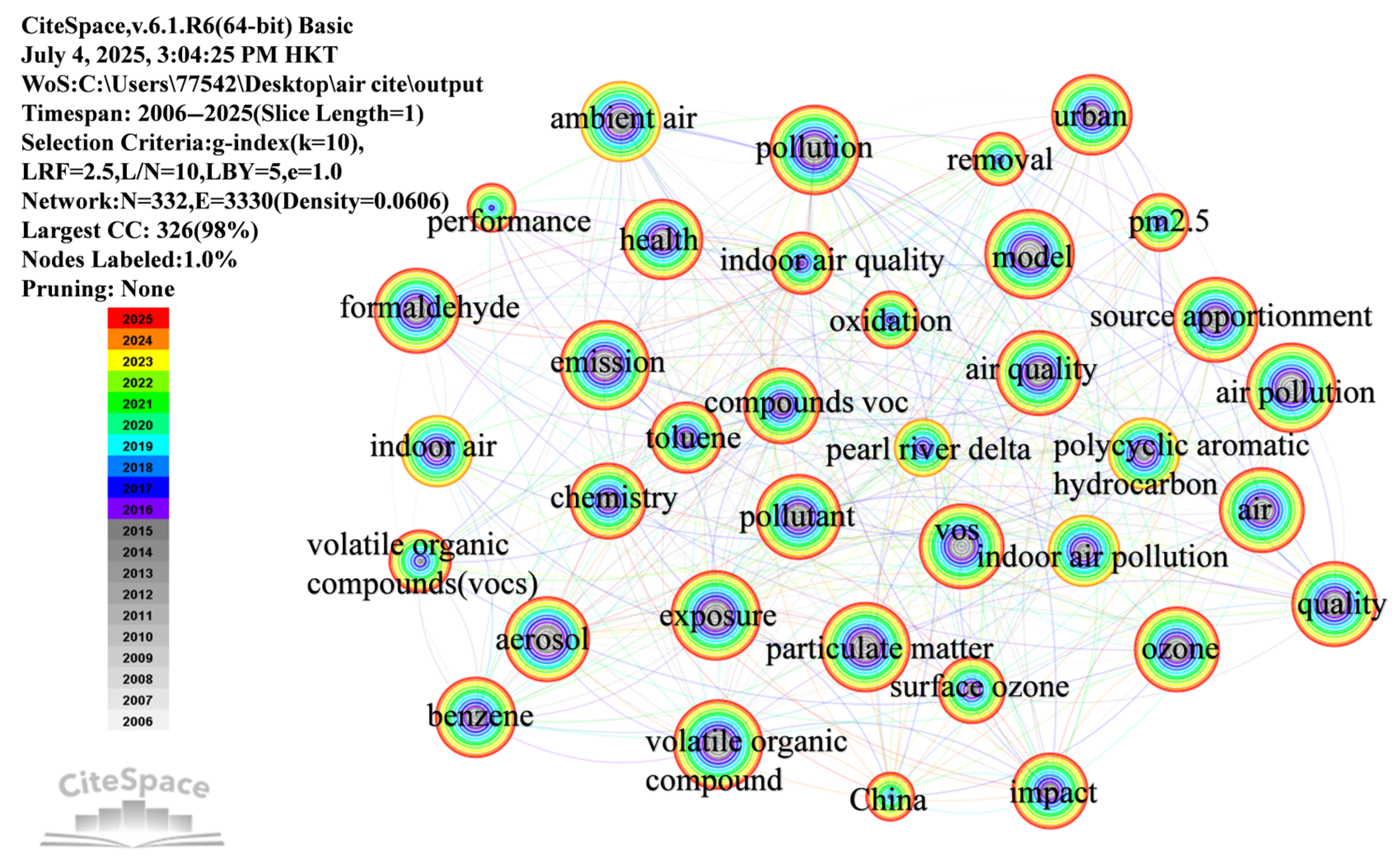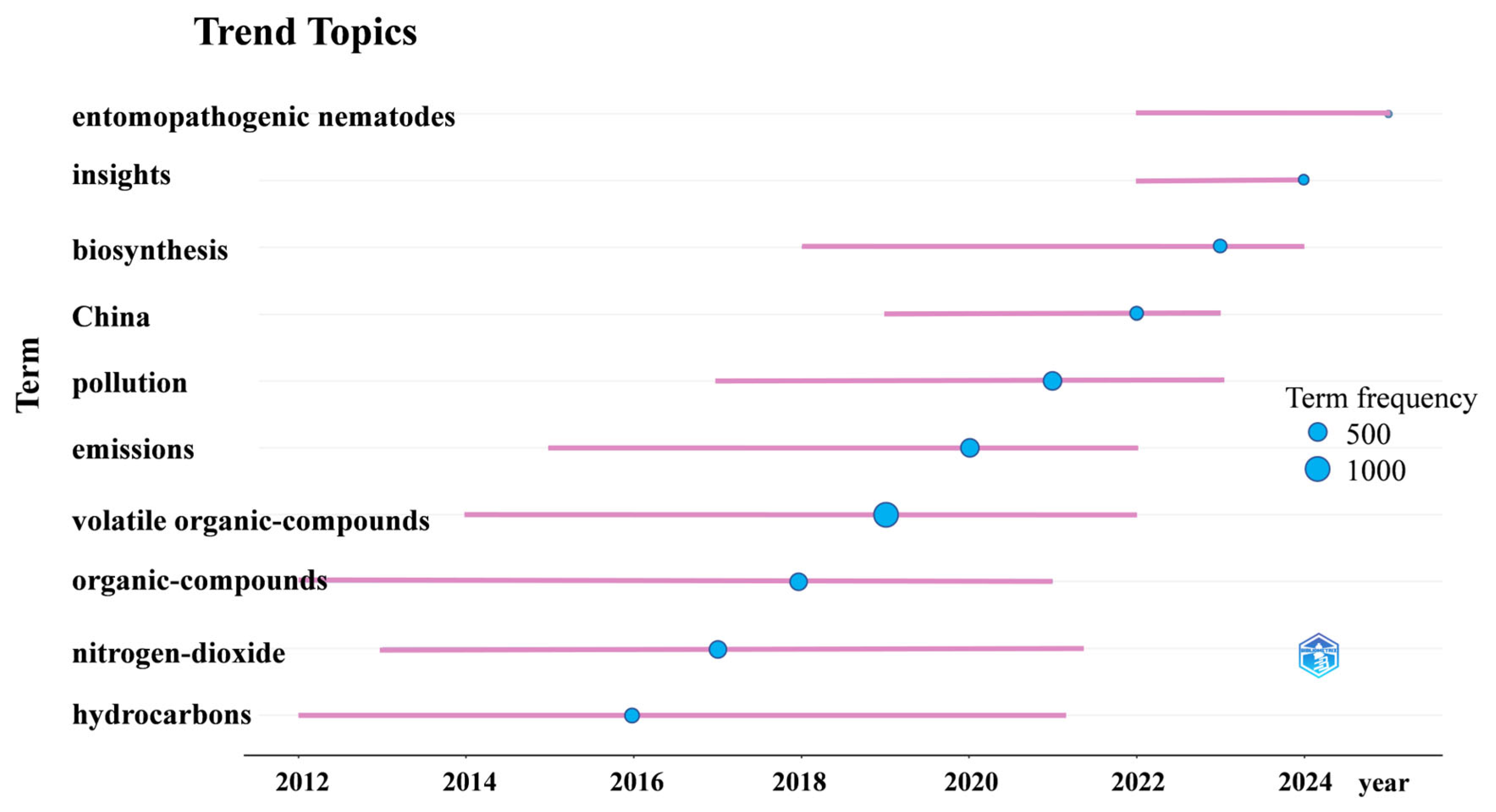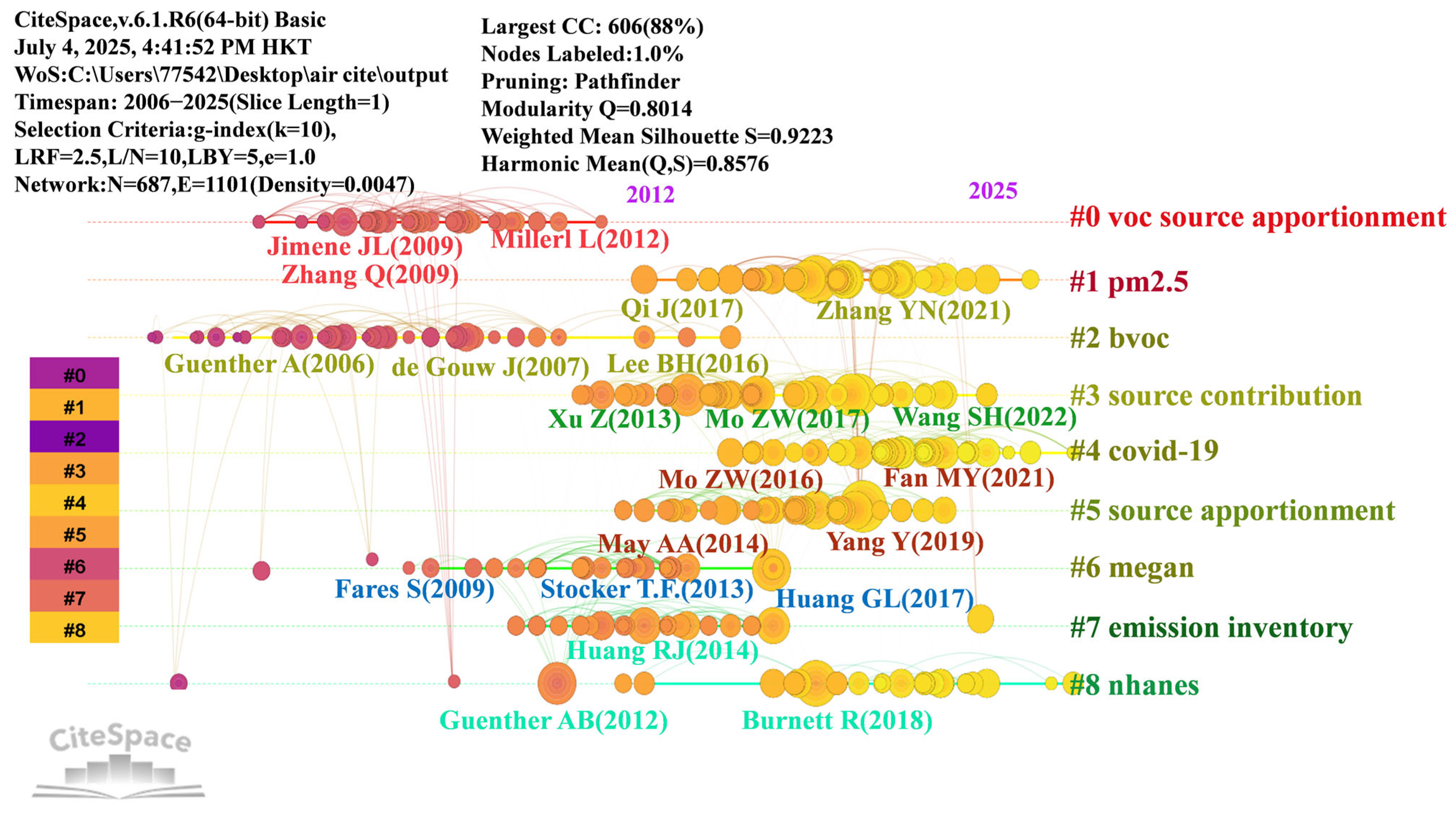1. Introduction
Volatile organic compounds (VOCs) are a class of organic pollutants characterized by high vapor pressure and strong chemical reactivity, making them prone to volatilization into the atmosphere under ambient conditions [
1]. Major sources of VOC emissions include industrial processes (e.g., petrochemical production, printing, coatings, and electronics manufacturing), transportation, residential renovations, and household cleaning products. With the acceleration of global industrialization and urbanization, VOC emissions have continued to increase [
2,
3]. As critical precursors to fine particulate matter (PM
2.5) and ground-level ozone (O
3), VOCs participate in complex photochemical reactions, contributing significantly to regional air pollution, with serious implications for environmental quality and public health [
4]. Accordingly, global institutions such as the World Health Organization (WHO) and the United Nations Environment Programme (UNEP) have identified VOCs as priority pollutants, calling for comprehensive strategies for their control and ecological risk assessment [
5].
In recent years, the study of VOCs has expanded beyond their indirect environmental impacts to include their direct ecological effects [
6]. Ecosystems serve as the foundation of life on Earth, and their stability is vital for maintaining global ecological balance and supporting biodiversity [
7,
8]. Once released into the atmosphere, VOCs undergo a variety of complex processes beyond simple transport and deposition. These include photochemical reactions with hydroxyl radicals (OH), ozone (O
3), and nitrate radicals (NO
3), leading to the formation of secondary organic aerosols (SOAs) and tropospheric ozone. Under certain meteorological conditions, VOCs may experience long-range transport across continents and oceans, especially when bound to fine particulate matter. Additionally, VOCs can undergo partitioning between the gas and particle phases, influencing their atmospheric lifetime and deposition behavior. In urban heat islands or regions with high radiation, VOC reactivity is often enhanced, accelerating their degradation into reactive intermediates. Furthermore, in cold or humid climates, VOCs may condense or adsorb onto surfaces such as building materials or vegetation, potentially re-volatilizing under temperature changes. These diverse scenarios reflect the dynamic atmospheric fate of VOCs, complicating efforts to model their environmental behavior and ecological impacts accurately [
9,
10,
11]. Moreover, many VOCs such as benzene, toluene, formaldehyde, acetaldehyde, and dichloromethane are known to be carcinogenic, mutagenic, and endocrine-disrupting, posing significant risks to flora and fauna. Evidence suggests that chronic exposure to VOCs can suppress immune function in aquatic organisms [
12,
13], reduce algal photosynthetic efficiency, and alter microbial community structures [
14]. Studies have also reported that VOCs affect terrestrial vegetation by altering leaf temperature, chlorophyll content, net carbon assimilation, and respiration rates; yet, many of these findings remain inconclusive and demand further verification [
15,
16].
Thanks to advances in environmental monitoring and modeling technologies, such as photoionization detectors (PIDs) [
17], Fourier-transform infrared spectroscopy (FTIR) [
18], gas chromatography–mass spectrometry (GC–MS) [
19], and laser-based remote sensing, our understanding of the spatiotemporal behavior of VOCs has improved significantly [
20]. Additionally, coupled atmospheric–ecological models such as the weather research and forecasting model with chemistry (WRF-Chem) [
21], community multi-scale air quality model (CMAQ) [
22], and comprehensive air quality model with extensions (CAMx) [
23] have been employed to simulate VOC emissions, transport, transformation, and deposition with greater precision. Recent integrative approaches combining high-throughput sequencing, metagenomics, and multi-omics analyses have enabled researchers to evaluate VOC-induced responses in plant and microbial communities from molecular to ecosystem levels [
24,
25,
26].
However, the ecological impacts of volatile organic compounds (VOCs), hereafter referred to as EIVOCs, have attracted increasing research attention in recent years due to their relevance to ecosystem functioning, biodiversity, and atmospheric chemistry. The current research on EIVOCs remains fragmented and insufficient. First, studies are geographically skewed, with most research concentrated in urban green spaces and industrial zones, while natural and semi-natural ecosystems such as forests, wetlands, and farmlands remain understudied [
27,
28,
29]. Second, the environmental pathways and ecological impact mechanisms of VOCs are still poorly understood. Comprehensive insight into the full-chain “pollution source–environmental medium–exposure route–ecological effect” is lacking, especially regarding soil–plant–animal interactions and biomagnification processes [
30,
31]. Moreover, most existing studies focus on individual organisms or species rather than community or ecosystem-level responses, which limits the development of effective remediation and policy strategies. The intensifying effects of global warming further compound the issue by accelerating VOC emissions and altering their chemical properties, thereby affecting plant-microbe interactions and critical ecological processes, such as carbon and nitrogen cycling. These complex dynamics call for integrative, multi-source modeling frameworks capable of assessing and predicting VOC ecological risks under evolving climate scenarios [
3,
32,
33,
34,
35,
36].
Despite the growing importance of this research area, a systematic and visualized bibliometric analysis on the EIVOCs is currently lacking. Traditional qualitative reviews are increasingly inadequate in capturing the evolution of this rapidly developing interdisciplinary field [
37,
38]. Bibliometric analysis offers a quantitative, data-driven approach to explore research trends, hotspots, and knowledge gaps by mapping the co-occurrence of keywords, citation patterns, and collaborative networks. Such analysis is essential to identify influential publications, core research groups, and emerging themes that might otherwise be overlooked [
39,
40].
To address this gap, the present study conducts a comprehensive bibliometric and visual analysis of English-language publications related to the ecological impact of VOCs, retrieved from the Web of Science Core Collection and Google Scholar databases, spanning the period from 2005 to 2024. Using CiteSpace, VOSviewer, and Bibliometrix, we construct a multi-dimensional knowledge map that focuses on six key aspects: temporal publication trends, geographic and institutional distributions, interdisciplinary characteristics, highly cited works, keyword clustering and thematic evolution, and co-citation network structures. Specifically, we aim to address the following scientific questions:
- (1)
What are the historical development patterns and evolution trends of EIVOC research?
- (2)
What are the current research hotspots and knowledge frontiers in this field?
- (3)
What are the future directions and potential breakthroughs for EIVOCs?
By filling a critical gap in the literature, this study contributes to the establishment of a comprehensive knowledge framework for EIVOC research. It not only provides a novel perspective on the synergistic development of air pollution control and ecosystem protection but also offers a scientific foundation for understanding the coupling mechanisms of pollution prevention, ecological restoration, and sustainable development. Furthermore, the insights gained here are expected to guide the transition of VOC research from pollutant-specific studies to a more integrated eco-health approach, thereby informing evidence-based environmental policies and cross-disciplinary collaboration. Although a growing body of research has explored the chemical characteristics, emission sources, and health effects of volatile organic compounds (VOCs), relatively few studies have focused on their ecological impacts, especially using systematic and quantitative methodologies. Most existing literature tends to adopt case-specific or experimental approaches, often targeting individual VOC species, specific environmental compartments, or single ecological effects such as phytotoxicity or microbial disruption. However, given the increasing complexity and interdisciplinarity of environmental sciences, there is a pressing need to understand how VOC-related ecological research has evolved over time, what intellectual structures underlie the field, and which emerging topics are gaining momentum. This is particularly important in the context of global climate change, biodiversity loss, and advancing environmental monitoring technologies. Therefore, the motivation of this study is two-fold: first, we aim to address the evident gap in providing a comprehensive, bibliometric-level synthesis of the ecological implications of VOCs; second, we will map the knowledge evolution, collaborative structures, and emerging themes in this research area. By leveraging powerful bibliometric tools such as CiteSpace, VOSviewer, and Bibliometrix, we aim to complement prior domain-specific reviews with a data-driven perspective that can guide future interdisciplinary research and policy design.
2. Materials and Methods
This study analyzes a total of 4662 articles related to the ecological impacts of volatile organic compounds (VOCs), retrieved from the Web of Science Core Collection and Google Scholar databases. The following sections describe the data collection, cleaning, and analysis procedures in detail. To ensure the rigor and reliability of this study, we sourced relevant literature from two globally recognized academic databases: Google Scholar and the Web of Science (WoS) Core Collection. These platforms are widely regarded for their broad interdisciplinary coverage, high-quality content, and continuously updated data, making them ideal for comprehensive bibliometric research [
41,
42,
43,
44].
2.1. Data Collection and Processing
A scientifically sound retrieval strategy was developed based on the research theme, combining flexible keyword structures, logical operators, and precise temporal constraints to ensure that the retrieved literature was both representative and comprehensive. All selected records were exported in a standardized format, preserving essential bibliographic metadata, including authors, affiliations, keywords, abstracts, and references. Notably, Google Scholar provides rich resources in engineering and environmental sciences, while Web of Science offers robust coverage of highly cited and authoritative journals. Combining both databases helped construct a more accurate and comprehensive knowledge framework.
To further enhance the validity and usability of the dataset, all initially screened documents underwent manual review to eliminate duplicate entries and irrelevant records. This quality control step helped to reduce redundancy and establish a solid foundation for subsequent visual analysis using specialized bibliometric tools, including Bibliometrix, VOSviewer, and CiteSpace.
2.2. Search Strategy and Clean Data Criteria
The data collection phase involved the systematic retrieval of information from Google Scholar and the Web of Science Core Collection. The advanced search used the following Boolean query: TS = (“volatile organic compounds” OR “VOCs”) AND TS = (“ecosystem” OR “ecological impact” OR “environmental impact” OR “air pollution” OR “ecotoxicology” OR “biodiversity” OR “plant response” OR “soil microbial community”).
The initial retrieval yielded 5413 records. After filtering for the publication type “article” and excluding books, conference papers, and other non-peer-reviewed documents, 4662 valid articles published between 2005 and 2024 were selected for final analysis. The metadata for each record included author names, document type, WoS categories, keywords, publication year, publisher, affiliations, and country/region information. To ensure temporal consistency and minimize the impact of daily database updates, the retrieval cut-off date was set as 31 December 2024. The keyword selection was based on the central research object, VOCs, which are widely studied in the fields of environmental science, ecotoxicology, and air pollution. The search incorporated both the full term and its common abbreviation. To focus specifically on the EIVOCs, an additional set of keywords was formulated, covering terms such as “ecosystem”, “ecological impact”, and “environmental impact”. Given the air-mediated dispersion and potential ecotoxicity of VOCs, terms like air pollution and ecotoxicology were also included. To capture biological and ecological response mechanisms, keywords such as biodiversity, plant response, and soil microbial community were incorporated. This multi-dimensional and complementary keyword strategy ensured the relevance and integrity of the dataset, thereby supporting robust bibliometric analysis and the accurate identification of emerging trends and research hotspots.
2.3. Data Export and Analytical Tools
The final dataset comprised 4662 articles, which were exported in a “plain text” format for compatibility with the selected analysis tools. Due to download limitations (a maximum of 500 records per export), the dataset was divided into four .txt files: File 1 (Records 1–500), File 2 (Records 501–1000), File 3 (Records 1001–1500), and File 4 (Records 4551–4662). The exported data were subsequently processed and visualized using three bibliometric software tools: (1) Bibliometrix (R version 4.2.2), was used for plotting keyword trend maps, international collaboration networks, and Sankey diagrams representing the relationships among keywords, authors, and journals; (2) VOSviewer (version 1.6.20) was applied to construct keyword co-occurrence networks, co-authorship networks, and journal citation maps; (3) CiteSpace (version 6.1.R1) was used for generating dual-map overlays of disciplines and journals, co-citation clustering networks, keyword timeline visualizations, and burst term detection. The schematic workflow is illustrated in
Figure 1, including three main phases: data collection, data processing, and data visualization.
2.4. Parameter Design and Key Metrics Description
To ensure the robustness of this study’s visual and quantitative analysis, three widely recognized bibliometric tools, CiteSpace, VOSviewer, and Bibliometrix, were employed in combination, each offering distinct strengths for analyzing and visualizing large-scale scientific data. The selection and configuration of each tool were carefully designed to maximize the clarity, relevance, and reliability of the resulting knowledge maps.
In the case of CiteSpace, a time-slicing approach was adopted, with one-year intervals defined as discrete time slices to capture the evolution of research trends over time. Within each time slice, the top 50 most cited items were selected for inclusion in the visual networks, allowing us to focus on the most impactful research during each period [
45,
46]. The node types were set to “keywords” and “authors,” enabling a dual perspective on both thematic evolution and intellectual collaboration. To reduce redundancy and enhance interpretability, pruning techniques such as sliced network pruning and pathfinder pruning were applied to eliminate irrelevant or overlapping connections in the network. To evaluate the quality and meaningfulness of the generated clusters, we focused on three core metrics. First, the modularity Q-value was used to assess the strength of the cluster structure; a Q-value above 0.3 indicates significant clustering and non-random grouping of nodes. Second, betweenness centrality was used to identify key nodes that act as bridges across different research communities, suggesting their importance in knowledge diffusion. Third, burst detection was applied to uncover research elements (e.g., keywords or references) that showed a sudden increase in citation frequency during a given period, often pointing to emerging topics or paradigm shifts in the field.
In addition, VOSviewer was used to construct a series of detailed visualizations that captured both the structural and temporal characteristics of the dataset. Three types of visual outputs were generated: network visualization, overlay visualization, and density visualization [
47,
48]. In network visualization, nodes represented entities such as keywords, authors, or institutions, with node size indicating frequency or importance, and edge thickness denoting the strength of co-occurrence relationships. Overlay visualization added a temporal dimension by assigning different colors to nodes based on the average publication year of the items they represent, providing a clear sense of how research topics evolved over time. Meanwhile, the density visualization mode displayed data as a heat map, where the concentration of terms was visually represented by a gradient from blue (low density) to yellow (high density). This method effectively highlighted areas of intensive scholarly activity, corresponding to current or sustained research hotspots.
Finally, Bibliometrix, an R-based package designed for comprehensive bibliometric analysis, was used to enrich and validate findings from CiteSpace and VOSviewer. This tool allowed flexible filtering of the dataset by publication year, document type, and other bibliographic parameters, and generated key performance indicators, including annual scientific production, average annual citation rate, and collaboration metrics. Additionally, Sankey diagrams were employed to visualize multidimensional relationships among authors, keywords, and journals, while co-authorship and co-occurrence networks were constructed to further explore collaborative structures and thematic development. The standardized dataset used across all three tools was derived from the cleaned corpus of 4662 publications exported from Google Scholar and Web of Science, ensuring consistency and comparability in the analysis. Collectively, this integrated approach to parameter design and metric selection enabled a robust and multidimensional exploration of the ecological impacts of VOCs in the global scientific literature [
49,
50,
51].
3. Results
3.1. Descriptive Bibliometric Analysis
As shown in
Figure 2, after excluding irrelevant or duplicate records, a total of 4662 articles related to EIVOCs were retrieved from the Web of Science Core Collection and Google Scholar databases for the period spanning 2005 to 2024. The figure clearly illustrates a significant upward trajectory in annual publication output, particularly after 2013, reflecting growing scholarly attention and intensified research activity over the past two decades. During the initial phase of the study period, the number of publications remained relatively modest and stable. However, two particularly notable surges occurred in 2016 and 2020, with annual growth rates of approximately 37% and 26%, respectively. In recent years, the field has sustained an average annual growth rate of 11.2%, suggesting steady expansion.
The year 2021 marked a significant milestone, recording the highest number of publications within the 20-year timeframe, with 453 articles published, accounting for 9.7% of the total dataset. This sharp increase in publication volume indicates a heightened and sustained research interest in the ecological consequences of VOCs, driven by growing environmental concerns, technological advancements in monitoring and modeling, and increasing interdisciplinary collaboration. Collectively, this trend underscores the rising recognition of VOCs as not only atmospheric pollutants but also critical agents influencing ecosystem health, biodiversity, and environmental sustainability.
In
Figure 2, we intuitively show the annual growth trend of articles in this field, and in order to better explain the specific information of publication output, we make a comprehensive supplement through the data in
Table 1.
Table 1 summarizes key bibliometric indicators of the research landscape. Between 2005 and 2024, a total of 4662 articles on the EIVOCs were published across 861 different journals, books, or other scholarly sources, involving 18,467 contributing authors. The average publication age of these articles was 6.72 years, and the field maintained a mean annual output of approximately 233.1 publications. The average number of citations per article stood at 32.5, reflecting the field’s strong scientific influence and active academic engagement. The dataset contains 158,492 cited references, further highlighting the depth and breadth of scholarly contributions to this topic. Among the total publications, only 68 articles were authored by a single researcher, whereas the remaining 4594 articles were produced through multi-author collaborations. This imbalance strongly suggests that the study of EIVOC is highly collaborative in nature, often requiring interdisciplinary expertise across environmental science, toxicology, ecology, and atmospheric chemistry. The calculated collaboration index, defined as the average number of authors per multi-authored article, was 4.02, reinforcing the notion that joint research efforts play a pivotal role in EIVOC field. The collaboration index refers to the average number of authors per multi-authored article. It is calculated by dividing the total number of authors of multi-authored papers by the total number of such papers. This metric reflects the degree of author collaboration within the dataset. This indicates a moderate to high level of collaboration, reflecting frequent teamwork and knowledge sharing among researchers. Compared to general scientific disciplines (with an average collaboration index between 2.5 and 3.5), the EIVOCs field shows a relatively stronger collaborative structure. However, it remains below the levels typically observed in highly networked domains such as global environmental health or climate science, where indices above 5.0 are common. These results suggest that while interdisciplinary and institutional cooperation is already taking place, further internationalization and integration across environmental subfields will be crucial for advancing the field and addressing the complex ecological risks associated with VOC emissions.
These bibliometric indicators offer important insights into the structure and evolution of research in the EIVOCs field. The increasing number of publications over recent years indicates a growing academic interest, reflecting the heightened global concern over VOC-related environmental and health risks. The average number of citations per article (32.5) highlights the field’s strong academic influence, which can be attributed to its interdisciplinary integration, combining atmospheric science, toxicology, ecology, and environmental policy. Furthermore, a collaboration index of 4.02 suggests that while many papers involve small author teams, there is a clear trend toward broader institutional collaboration, signaling the development of a more connected and cooperative research network. Together, these metrics demonstrate that EIVOC research is becoming both mature and socially impactful.
3.2. Classification of the Literature in the EIVOC Field
Based on the refined dataset retrieved from Google Scholar and the Web of Science Core Collection, a total of 4662 publications related to VOCs were analyzed. These publications were further categorized into four major research themes according to keyword clustering and thematic relevance, as illustrated in
Figure 3a. The largest category comprises 2671 articles, primarily focusing on the environmental behavior, transformation pathways, and ecosystem-level reactive mechanisms of VOCs. The second group includes 1113 publications, which investigate the ecological effects of VOCs on plant systems and soil microbiomes. The third category, consisting of 726 publications, centers on ecological risk assessment and environmental exposure analysis of VOCs. This distribution clearly indicates that the migration and transformation of VOCs within ecological environments has emerged as the most intensively studied area in recent years.
A co-citation clustering analysis conducted using CiteSpace further revealed key research subdomains, with each cluster representing a specific thematic concentration. As shown in
Figure 3b, the cluster associated with the ecological impacts of VOCs (EIVOCs) on plants and soils was examined in detail. Within this theme, a substantial portion of the literature emphasizes the biological effects and biotic mediation of VOCs. Prominent clusters include studies on the ecotoxicity of phenolic compounds, plant growth induction, and the functional roles of Trichoderma and Streptomyces, as well as ecophysiological responses under drought conditions. The cluster focusing on phenolic compound toxicity sheds light on the complex, and sometimes beneficial, interactions between VOCs and plant development. The Trichoderma and Streptomyces cluster underscores the critical role of soil microbiota in mediating VOC transformation. Meanwhile, the drought-related cluster highlights the intricate interplay between environmental stressors and EIVOC responses. The high modularity and silhouette values observed in these clusters indicate strong internal coherence and clear thematic boundaries.
Figure 3c presents the keyword clustering results for the thematic area of ecological risk assessment and environmental exposure. One prominent cluster centers on exposure pathways, delineating the mechanisms through which VOCs enter biological systems and environmental compartments. The frequent appearance of gas chromatography–mass spectrometry (GC–MS) within this cluster reflects its indispensable role in the accurate identification and quantification of VOCs. Another significant cluster revolves around health impacts, emphasizing the growing research focus on toxicological and epidemiological consequences of VOC exposure. Consistently high modularity and silhouette scores further confirm the tight focus and analytical clarity within these research domains.
Figure 3d displays the keyword co-occurrence clustering results related to the environmental behavior and transformation mechanisms of VOCs. This cluster captures a wide range of research on source apportionment, atmospheric reactivity, and the role of VOCs in secondary processes, such as new particle formation, ozone generation, and oxidative capacity alteration. The diversity of research methods and the integration of multiple scientific disciplines in this cluster illustrate the complex, multi-phase pathways through which VOCs interact with ecological systems and atmospheric chemistry.
As shown in
Figure 3, the co-occurrence network reveals a complex and multidimensional research landscape. The six identified clusters reflect diverse yet interconnected thematic areas: from atmospheric chemistry “ozone formation sensitivity” and “new particle formation” to analytical methodologies “using various methods”, source apportionment and modeling, and core VOC concepts. The integration of terminology across multiple scientific domains demonstrates that VOC ecological research is becoming increasingly interdisciplinary. This trend is driven by the need to assess VOCs’ environmental effects not only from a chemical perspective, but also through ecological modeling, toxicological analysis, atmospheric transport dynamics, and remote sensing tools. The structure of this keyword network highlights a growing convergence between environmental science, ecology, chemistry, physics, and data science, marking a clear shift toward a highly integrated field of study.
3.3. Co-Country or Region Network Analysis
Table 2 presents the top ten countries and regions in terms of publication output within the research field of EIVOC, along with several key bibliometric indicators, including C* (number of publications), L* (total citations), TLS* (total link strength), A* (average citations per publication), Co* (collaborative links), and AC* (average co-authorship). Among all contributing countries, China ranks first with 1550 publications, followed by the United States with 1142 publications. As two leading global scientific powers, both countries have made substantial contributions to the development of this research area. Citation count is a key metric for evaluating scholarly influence at the national level. China and the United States top the list with 56,157 and 51,617 total citations, respectively, reflecting their strong research impact and widespread recognition in the academic community. In terms of average citations per publication, Germany (53), Japan (49), and France (47) stand out, suggesting that although these countries have relatively lower publication volumes, the scientific quality and influence of their outputs are notably high.
Taken together, the data demonstrate that the United States maintains a dominant position in terms of research quality and international influence, while China is rapidly emerging as a central hub for EIVOC studies. This shift illustrates China’s increasing investment in environmental research and global scientific collaboration. Overall, the active participation of multiple countries and regions has significantly accelerated the development and globalization of research in this domain.
As presented in
Figure 4, a set of three collaboration network visualizations was generated using VOSviewer, aimed at providing a comprehensive overview of international cooperation patterns and network densities in the field of EIVOCs research. These include (a) a general country/region collaboration network, (b) an overlay visualization based on publication years, and (c) a density visualization representing the intensity of collaborative activities.
As presented in
Figure 4a, each node represents a country or region, with node size indicating both publication volume and collaborative intensity. Larger nodes correspond to countries with higher research output and more extensive international engagement. The edges (lines) between nodes reflect cooperative relationships, with thicker lines representing stronger collaborative ties. The visualization reveals that the United States and China occupy the most central positions, with the largest nodes and the highest degree of connectivity. The United States demonstrates a wide-reaching global network, actively collaborating with numerous countries across different continents. In contrast, China shows a stronger regional orientation, particularly in collaborations with other Asian countries. These patterns align well with the bibliometric data presented in
Table 2.
Figure 4b introduces a temporal overlay that maps the evolution of collaboration networks over time. The color gradient, ranging from blue (earlier years) to green (middle years) and yellow (recent years), indicates the average publication year for each country’s collaborative activity. From this visualization, it becomes evident that countries such as the United States, Germany, and France have established strong international partnerships from the early stages of the research field. Meanwhile, China has emerged prominently since 2012, reflecting its rapidly increasing influence and activity—consistent with the upward trajectory in publication volume illustrated in
Figure 2.
As displayed in
Figure 4c, a density visualization of international collaboration, where warmer colors (yellow) signify higher levels of cooperative activity and network density. The most prominent yellow cluster appears between China and the United States, underscoring their central roles as hubs in the global VOCs research landscape. In addition to this dominant hub, several European countries, including Germany, France, Italy, and Spain, form tightly connected regional clusters with high collaboration density, as shown by the warm-toned zones in the heatmap. While we previously referred to this as a “secondary cluster,” we now acknowledge that it consists of multiple interconnected European sub-clusters, each exhibiting strong intra-regional collaboration. This reflects the presence of distributed but regionally cohesive research networks within Europe, rather than a single uniform group.
3.4. Disciplines and Journals Analysis
3.4.1. Category and Disciplinary Landscape
The dual-map overlay generated by CiteSpace serves as an effective tool for visualizing the disciplinary landscape and citation trajectories within scientific research. This visualization method superimposes a citing journal map (on the left) over a cited journal map (on the right), thereby illustrating the direction and intensity of knowledge flows across disciplines. In
Figure 5, the left side represents the disciplines or subject categories of the citing articles, which reflect the current research frontiers. The right side, in contrast, corresponds to the disciplines of the cited articles, representing the foundational domains or knowledge sources upon which recent research builds. The colored curved paths connecting the two sides indicate interdisciplinary citation linkages, showing, for example, how research in environmental sciences draws upon foundational work in chemistry, biology, or atmospheric science. The thickness and frequency of these paths reflect the strength and frequency of citation relationships, thereby offering a clear picture of how knowledge is transferred and integrated across scientific fields. The citing disciplines on the left side are primarily concentrated in ecology (SECOLOGY), earth sciences (EARTH), marine sciences (MARINE), physics (SPHYSICS), materials science (MATERIALS), chemistry (CHEMISTRY), and veterinary and animal sciences (TVETERINARY ANIMAL SCIENCE). This distribution indicates that the EIVOCs are being explored through a highly interdisciplinary lens. Among these, environmental science stands out as the core application domain, while chemistry serves as the foundational discipline, offering essential insights into the physicochemical properties, detection techniques, and transformation mechanisms of VOCs. Notably, the presence of veterinary and animal sciences reflects growing research attention to the ecotoxicological effects of VOCs on animal health, livestock systems, and broader ecosystem responses.
On the right side, the cited disciplines reveal the foundational pillars upon which current research builds. The most frequently cited fields include environmental science (23ENVIRONMENTAL), toxicology (TOXICOLOGY), nutrition (NUTRITION), plant science (1OPLANT), ecology (ECOLOGY), and zoology (ZOOLOGY), along with chemistry (4CHEMISTRY), materials science (MATERIALS), and physics (PHYSICS). Among them, environmental science (23) emerges as the most frequently cited domain, indicating that research outputs in the VOC–ecology interface are strongly grounded in this discipline. This is consistent with the citing pattern on the left, reinforcing the field’s central reliance on environmental and toxicological frameworks. Chemistry (4) and plant science (10) also play critical supporting roles, especially in studies related to plant physiological responses, bioaccumulation, and pollutant degradation mechanisms.
3.4.2. Journals
To evaluate journal-level productivity and disciplinary distribution within the EIVOCs research field, we employed VOSviewer to generate a journal co-occurrence network (
Figure 6) and compiled the top 10 journals by publication volume (
Table 3). The co-occurrence network visualizes the relationships between journals, where each node represents a specific journal. A link between two nodes indicates that publications from both journals have co-appeared in the same bibliographic dataset: the thicker the link, the higher the co-occurrence frequency. Node colors represent distinct clusters, with journals in the same cluster sharing closer thematic connections and similar research focus.
As shown in
Figure 6, the network is structured around three major clusters, each corresponding to a key research direction. The green cluster, located in the upper central area of the network, is dominated by journals in the field of environmental science and pollution control. These include
Science of the Total Environment,
Environmental Pollution,
Environmental Science and Pollution Research, the
Journal of Environmental Sciences, and
Atmosphere. These journals emphasize the integrated environmental impacts of VOCs, pollution mitigation strategies, environmental governance, and clean production technologies. The purple cluster, situated on the right side of the network, represents journals focused on atmospheric chemistry and physics, such as
Atmospheric Chemistry and Physics and
Atmospheric Environment. These outlets investigate the chemical and physical behavior of VOCs in the atmosphere, including photochemical reactions, ozone and secondary aerosol formation mechanisms, long-range atmospheric transport, and advanced measurement techniques. The red cluster, on the left side of the network, centers on research related to health exposure and the built environment. Journals such as
Environmental Research and
Building and Environment are representative of this cluster, addressing human exposure assessment to VOCs in both indoor and outdoor environments, along with associated health impacts and epidemiological studies.
Table 3 presents detailed statistics for the top ten journals in terms of publication output.
Atmospheric Environment and
Atmospheric Chemistry and Physics rank first and second, with 353 and 282 publications, respectively. This aligns with their central positions in the co-occurrence network, affirming their status as core journals in atmospheric VOC research. Notably,
Atmospheric Chemistry and Physics also leads in total citations (20,449) and average citations per article (73), highlighting its significant academic impact in the field. However, when considering the H-index, a different picture emerges. Although
Environmental Science & Technology has a relatively lower publication count, it boasts a remarkably high H-index of 480, far exceeding other journals. This suggests that the journal holds long-standing influence and is highly cited in the broader environmental science community.
Collectively, insights from
Figure 6 and
Table 3 reveal that research on EIVOCs is predominantly published in journals specializing in atmospheric science, environmental science, and environmental engineering. Moreover, the dense interconnections among journals reflect a high degree of interdisciplinary collaboration. As research challenges in this field continue to grow in complexity, there is a pressing need to further enhance cross-disciplinary integration and cooperation to develop more holistic and effective solutions.
Figure 7 presents a Sankey diagram generated using Bibliometrix, offering a multidimensional visual representation of the relationships among research keywords, prolific authors, and core journals. This type of visualization effectively reveals the knowledge production network, author co-occurrence patterns, and interconnections between journals within the EIVOCs research field. In addition to the graphical insights,
Table 4 complements this analysis by detailing the top 10 high-impact authors and their affiliated institutions, providing a deeper understanding of the key contributors in this area of study. In the Sankey diagram, line thickness indicates the frequency of co-occurrence or connection strength: thicker lines denote stronger associations and more frequent interactions. Notably, the terms “volatile organic compounds” and “VOCs” are prominently linked with multiple prolific authors, reflecting their central role in the general research landscape of VOCs. These high-output researchers have published extensively in several core journals of the field, including
Science of the Total Environment,
Atmospheric Chemistry and Physics, and
Atmosphere. The many-to-many linkage pattern observed suggests that prolific authors tend to submit their work to high-impact journals, while these journals, in turn, attract significant attention from leading scholars.
Based on the statistical data in
Table 4, institutions such as the Chinese Academy of Sciences and Peking University host a substantial number of high-impact authors, underscoring their institutional strength and research capacity in the field of EIVOC. This also highlights the growing research intensity and international visibility of Chinese research teams in this domain. Through this integrated analysis of authors, keywords, and journals, the study offers valuable insights into the intellectual structure and emerging trends of EIVOC research. The observed patterns not only identify key contributors and preferred publication venues but also delineate the research hotspots and developmental trajectories that drive future exploration in this highly interdisciplinary field.
3.4.3. Author Analysis
To explore the collaborative structure within the field of EIVOCs, a co-authorship network was constructed using VOSviewer, as shown in
Figure 8. This network visualization facilitates the identification of key research teams or clusters and offers insights into the patterns of academic collaboration and the underlying social structure of the field. The result reveals several prominent author clusters, with particularly notable groups based in China and Europe. Among them, the Chinese research teams centered around Shao M. and Wang X. form two of the largest clusters in the network, represented in blue and brown, respectively. These authors are primarily affiliated with leading Chinese research institutions and exhibit dense interconnections, reflecting strong internal collaboration and a high degree of academic productivity. Their work often spans a broad range of topics, including VOC emissions, atmospheric chemistry, and environmental risk assessment.
In contrast, a European cluster led by Rinnan R. appears in purple, with a research focus more specifically oriented toward the ecological roles and emission mechanisms of biogenic VOCs (BVOCs). This group maintains a distinct thematic orientation, contributing significantly to the understanding of plant–atmosphere interactions and biosphere-atmosphere feedback under changing environmental conditions. From the above analysis, the co-authorship network underscores the international and interdisciplinary nature of EIVOC research, while also highlighting the formation of regional research hubs. These collaborative structures are critical for advancing comprehensive and integrative approaches to understanding environmental behavior and EIVOCs.
Table 5 summarizes the top ten most productive authors in the field of VOC ecological impact research, along with five key bibliometric indicators. In terms of publication volume, Rinnan R. ranks first with 35 publications, followed closely by Wang S. and Wang X., each contributing 30 articles. Additionally, Shao M. has authored 29 publications. Notably, these three prolific authors are all affiliated with leading Chinese institutions, underscoring the significant contribution of Chinese researchers to this field. In terms of academic impact, Zhang Q. stands out with a total citation count of 4842 and an average citation rate of 211 per article, far surpassing other listed authors. This indicates that Zhang’s work has garnered substantial recognition and influence within the academic community. Collectively, these findings highlight that high-impact scholarship, coupled with extensive collaborative networks, serves as a key driving force behind the continued advancement and innovation in VOCs-related ecological research.
3.5. Reference Co-Citation Network Analysis
Co-citation refers to the phenomenon where two or more documents are cited together by a third or subsequent publication, indicating a perceived thematic or conceptual relationship between them. In bibliometric analysis, co-citation networks are widely used to uncover the intellectual structure of a research field by identifying clusters of frequently co-cited references.
Figure 9 presents the co-citation network clustering view generated using CiteSpace, which reveals the underlying knowledge domains and research trajectories within the EIVOC field. In this study, the modularity value (Q) of the network was calculated to be 0.8014, significantly exceeding the threshold of 0.3, indicating a well-defined cluster structure with distinct boundaries between research areas. Additionally, the mean silhouette score reached 0.9223, close to the ideal value of 1.0, suggesting a high degree of internal consistency and structural reliability within each cluster.
A total of nine distinct clusters were identified, revealing a comprehensive overview of the research hotspots in EIVOCs research. Among these, Cluster #1 (PM2.5) is one of the largest, focusing on the influence of VOCs on the formation, composition, and ecological effects of fine particulate matter through secondary organic aerosol (SOA) generation. This finding aligns with prior research emphasizing the role of VOCs in atmospheric transformation processes.
Cluster #3 (source contribution) and Cluster #5 (source apportionment) are spatially adjacent and partially overlapping, indicating a close thematic relationship. These clusters mainly focus on the identification of VOC emission sources, quantification of source contributions, and the application of such information to pollution control strategies, which are critical for designing effective emission reduction policies. Cluster #4 (COVID-19) highlights research on VOC exposure and associated health risks in both indoor and outdoor environments during the pandemic. Meanwhile, Cluster #6 (MEGAN) underscores the importance of BVOC emissions, with researchers employing modeling tools such as the MEGAN model to simulate and predict BVOC contributions. This cluster offers scientific grounding for ongoing advancements in the field. Altogether, the clustering results delineate several key thematic directions within EIVOC research and highlight the multidimensional nature of this evolving domain.
3.6. Keyword Analysis
3.6.1. Keyword Co-Occurrence Network Analysis
Table 6 systematically presents the top ten most frequently cited keywords in the field. Using four core indicators generated by CiteSpace, we analyzed key research hotspots and thematic areas. Among them, “air pollution” ranks first with a total of 2061 citations, followed by “source apportionment” and “health”, with 1415 and 624 citations, respectively. The betweenness centrality, a critical metric for assessing the importance of keywords within the network, shows relatively small variation across the top ten terms, indicating that each keyword represents a significant focus within the field. Overall, the core research themes are centered around air pollution, including studies on the properties of VOCs, source apportionment techniques, emission mechanisms, and the human health impacts and exposure pathways. Additionally, the use of modeling tools to elucidate ozone formation mechanisms is emerging as another prominent area of investigation. These trends reflect the field’s ongoing emphasis on understanding both the environmental behavior and public health implications of VOCs.
In this study, a keyword co-occurrence network was constructed based on 4662 articles using the CiteSpace tool, as illustrated in
Figure 10. This network offers a comprehensive visualization of the co-occurrence relationships among key terms in the field of EIVOCs, while also highlighting temporal patterns in research focus. At the core of the network lie keywords such as “volatile organic compounds” and “VOCs”, which are central nodes with multicolored rings, an indication that these topics have been consistently studied across the entire timeframe analyzed. Closely associated terms, including “air pollution”, “air quality”, “emission”, “exposure”, and “health”, are also prominent, as reflected by their sizable nodes and diverse color rings, signifying their foundational importance within the field.
Notably, “air pollution” and “air quality” not only feature large nodes but also exhibit a high number of connecting edges, indicating that they serve as both the starting points and focal areas of EIVOC research. The network also reveals tight clusters involving specific pollutants such as “ozone”, “formaldehyde”, “toluene”, and “polycyclic aromatic hydrocarbons”, along with atmospheric concepts like “atmospheric chemistry”, “aerosol”, and “surface ozone.” These reflect recent areas of heightened academic interest.
The temporal evolution embedded within the network suggests that while traditional research themes remain active, new directions are continuously emerging, accompanied by increasing the research depth. For example, topics such as PM2.5 and indoor air quality have become particularly prominent in current studies, signaling a broadening of the field’s scope and the growing complexity of research agendas.
3.6.2. Keyword Trend Analysis
A hotspot trend map generated using the Bibliometrix software is presented in
Figure 11, illustrating the temporal evolution of research keywords in the field of EIVOCs from 2012 to 2024. By aligning the horizontal axis with time and the vertical axis with keyword distribution, this visualization allows for a clear examination of the activity levels of different keywords across years, thereby revealing major research trends and directions within the field.
The terms “volatile organic compounds” and “organic compounds” maintained consistently high levels of prominence throughout the observed period, with a notable surge in frequency around 2019. This underscores their foundational role as core concepts within VOC-related studies. Keywords such as “pollution” and “emissions” also remained persistently active, reflecting ongoing research interest in environmental contamination and emission control associated with VOCs. In contrast, the keyword “biosynthesis” began to gain traction predominantly after 2018, signaling a growing focus on the generation mechanisms of BVOCs, as well as on interactions between plants and microorganisms. Notably, “entomopathogenic nematodes” emerged as one of the most recent and specialized terms, indicative of an advanced and niche research frontier. Its appearance suggests potential links to the application of VOCs in biological control and ecotoxicological assessments.
3.6.3. Time-Zone Visualization Map Analysis
As shown in
Figure 12, it presents a time-zone visualization map generated by CiteSpace, illustrating the developmental trajectory of research on the EIVOCs from 2005 to 2024. In this map, each node represents a scholarly publication, with node size corresponding to the number of publications and their citation frequency. The lines connecting the nodes indicate the relationships between keywords, where shorter link distances suggest stronger thematic correlations. The analysis yielded a modularity Q value of 0.8014, which is well above the threshold of 0.3, indicating a highly significant clustering structure with clearly defined boundaries among different research domains. Furthermore, the Silhouette value (S) of 0.9223, a metric used to assess the internal consistency of clusters, approaches 1, confirming that the clusters are cohesive and structurally reliable.
From a content perspective, the field has evolved through several distinct stages. The early phase focused on establishing foundational concepts, which gradually expanded to include studies on source apportionment of VOCs, the construction of emission inventories, and investigations into biogenic VOCs (BVOCs). In recent years, research attention has increasingly turned toward the relationship between VOCs and PM2.5, as well as the assessment of health impacts, marking a shift toward application-oriented and socially relevant studies.
3.6.4. Analysis of Burst Keywords
From 2005 to 2024, a burst detection analysis was conducted to identify the top ten keywords with the highest citation bursts in the field of research on the EIVOCs. The results are summarized in
Table 7. Citation burst analysis aims to capture keywords that exhibit a rapid increase in citation frequency over a short period, thereby reflecting emerging research focus or areas of heightened academic interest. In the visual representation, red bold lines indicate burst periods, while thin blue lines denote non-burst periods. The Strength value reflects the magnitude of the burst, with higher values indicating greater intensity.
Specifically, the keyword “atmosphere” exhibited a strong burst beginning in 2005 and lasting until 2018, with a strength of 15.57. This suggests that during the early stages of EIVOC research, the atmospheric environment served as the primary context and focus. Researchers at the time concentrated on VOC emissions, their transformation processes in the atmosphere, volatility characteristics, and residence time, which are all foundational topics that paved the way for more advanced investigations [
73,
74,
75].
The term “air pollution source” also began to exhibit a burst in 2005, lasting until 2017, with a strength of 11.45. One of the central objectives of early research was to identify the sources of VOCs, distinguishing between natural and anthropogenic origins and quantifying their relative contributions. These studies provided critical scientific support for developing evidence-based pollution control policies [
76,
77,
78].
The keyword “children” showed a burst from 2005 to 2015, with a strength of 9.27, indicating an early research emphasis on the health impacts of VOC exposure on children. Due to their distinct physiological characteristics and behavioral patterns, children are more vulnerable to air pollutants. Consequently, topics such as the effects of VOCs on respiratory health, neurological development, and allergic responses became key areas of public health research [
79,
80,
81].
The term “reaction mass spectrometry” demonstrated a burst from 2005, with a strength of 11.45. As a highly sensitive real-time analytical technique for VOC detection, it has enabled the rapid and accurate monitoring of trace VOCs in complex atmospheric and biological samples, significantly advancing studies in environmental science, atmospheric chemistry, and ecological systems [
82,
83].
In recent years, “ozone pollution” has emerged as a prominent burst keyword, with a strength of 10.96, spanning from 2021 to 2024. This indicates growing research attention toward ozone-related environmental problems and management strategies. The keyword includes studies on regional ozone transport, seasonal variation, ecological toxicity to crops and forests, and emission control measures targeting VOCs and nitrogen oxides to mitigate ozone pollution. This shift reflects a transition from fundamental research to applied policy development and environmental governance [
84,
85].
The remaining five burst keywords collectively illustrate a broader trend. In the earlier period, research focused on the atmospheric context, specific VOC compounds, pollution source identification, and health risks to children, with particular attention to BVOC emissions. Since 2020, however, the field has increasingly prioritized understanding ozone formation mechanisms, controlling secondary pollution, and implementing refined anthropogenic emission strategies.
4. Conclusions
This study presents a comprehensive bibliometric analysis of research on EIVOCs from 2005 to 2024. The results reveal a marked upward trend in publication volume, particularly after 2013, when the annual number of publications rose from 153 in 2013 to 418 in 2022. This growth aligns closely with the intensification of environmental protection policies introduced since 2013, which have significantly stimulated research in this domain. Utilizing advanced bibliometric tools, including Bibliometrix, CiteSpace, and VOSviewer, we systematically identified and summarized key patterns and trends within the field. These include publication dynamics, international collaborations, thematic evolution, core journals, and prolific authors, collectively offering a robust foundation for constructing a knowledge framework and guiding future research directions in EIVOC studies.
Co-occurrence network analyses at the national/regional level indicate that China and the United States are the leading contributors to this field, with 1550 and 1142 publications, respectively. In recent years, China’s research output has grown significantly, as reflected in the VOSviewer co-occurrence and density maps, where green and yellow nodes signal recent and rapidly growing activity. Influential scholars such as Wang Shuxiao, Zhang Qiang, and Hao Jiming, all affiliated with top Chinese research institutions, further underscore China’s ascendant leadership. Meanwhile, Europe, particularly Germany, has formed another prominent research cluster, with Germany achieving the highest average citation count (53), reflecting the high quality and impact of its publications.
The evolution of research themes is clearly visualized in
Figure 11 and
Figure 12. During the early stage (2005–2015), studies primarily focused on emission characteristics of VOCs and their behavior in the atmosphere, including specific compounds such as hydrocarbons and carbonyls, as well as their health effects on children. BVOC emissions and the application of analytical techniques, such as reaction mass spectrometry, were also emphasized. As the field progressed, attention shifted toward accurate source apportionment, including the development of emission inventories and quantification of VOC contributions to ozone formation and PM
2.5 levels, as illustrated by Clusters #3, #5, and #1 in
Figure 9. Additionally, studies expanded to examine the role of anthropogenic emissions and the impacts of public health events (Cluster #4), indicating a transition from basic understanding to tackling complex environmental mechanisms and health risk assessments.
The interdisciplinary nature of the field is further highlighted by the journal co-occurrence network (
Figure 6), keyword co-occurrence analysis (
Figure 10), and the high-frequency keywords listed in
Table 6. Core journals include
Atmospheric Chemistry and Physics, focusing on atmospheric science,
Science of the Total Environment and Environmental Pollution, addressing broader environmental issues, and
Building and Environment, which connects environmental research with public health and built environments. Notably,
Atmospheric Chemistry and Physics reports an average of 73 citations per article, while
Environmental Science & Technology holds a striking H-index of 480, underscoring the scholarly influence of these journals. Keyword analyses reveal that terms such as “air pollution”, “source apportionment”, and “emissions” serve as critical conceptual bridges across subfields. The prominence of terms like “health” and “exposure” with high centrality also reflects the field’s growing concern with environmental governance and public health implications.
In summary, EIVOC research has evolved from pollutant characterization to a holistic understanding of emission mechanisms, atmospheric transformations, and ecological and health consequences. This trend highlights the importance of continued interdisciplinary collaboration and policy-oriented innovation to address emerging environmental challenges.
5. Perspectives
Although the number of publications in the field of EIVOCs has increased steadily over the past two decades, global research collaboration remains uneven. As revealed by the co-authorship network (
Figure 4), China and the United States dominate the field with 1550 and 1142 publications, respectively. However, China’s collaborations are largely regional, while the U.S. engages in broader international networks. This regional imbalance hampers the establishment of globally coordinated emission inventories and ecological risk frameworks. Future research should prioritize building transnational, interdisciplinary collaborations, particularly between the Global North and South, to address transboundary VOCs transport and foster harmonized pollution mitigation strategies.
In terms of research hotspots, although keywords such as “air pollution”, “source apportionment”, “emissions”, “health”, and “exposure” have emerged as central themes and the focus has gradually shifted from single pollutant factors to systemic mechanistic processes, current studies remain predominantly centered on micro-level and localized mechanisms. Therefore, future research should extend beyond these established hotspots to emphasize system-level responses, such as changes in community structure and biodiversity loss. A multi-scale integrated research framework encompassing genetic, physiological, population, community, and ecosystem levels is required to develop predictive models of ecosystem responses to VOC disturbances [
86,
87]. Interdisciplinary integration should also be strengthened, particularly among ecotoxicology, molecular ecology, and atmospheric sciences. Furthermore, to address the amplified ecological risks of VOCs under climate change, a multi-scenario coupled modeling platform should be established, incorporating variables such as land-use change, extreme climate events, and anthropogenic activities. This approach will support the development of dynamic ecological risk forecasting and emergency response technologies to identify potential high-risk zones in advance. Ultimately, the goal is to embed ecological impact assessments into air quality management and environmental planning frameworks, establish a feedback mechanism that links VOC emission intensity, ecological risk, and management interventions, and promote a dual emphasis on source-based pollution control and ecosystem restoration. This strategy will enable synergistic gains in ecological security and sustainable development [
88,
89,
90,
91].
The temporal evolution of research themes (
Figure 11 and
Figure 12) illustrates a shift from foundational studies on VOC emissions and atmospheric behavior toward health risk assessments and secondary pollution formation, such as ozone and PM
2.5. However, much of the work remains model-based, with limited empirical validation under real-world ecological conditions. There is a clear need for integrated research frameworks that combine high-resolution atmospheric observations, biological response monitoring, and multimedia VOCs fate tracking. Such efforts will bridge the gap between simulated outcomes and ecological realities, enhancing the robustness and applicability of findings to environmental and public health management [
92,
93,
94].
The emergence of keywords such as “biosynthesis” and “entomopathogenic nematodes” (
Figure 11) reflects the increasing specialization and depth of research in recent years. Nevertheless, a prevailing focus on the detrimental effects of VOCs overlooks their potential ecological functions. For instance, some BVOCs play crucial roles in plant defense, microbial interactions, and ecosystem signaling. The current literature lacks a balanced exploration of both the negative and positive ecological roles of VOCs. Future research should adopt a broader ecological perspective that considers VOCs’ multifunctionality within ecosystems, which could inform sustainable applications such as biological pest control or ecosystem-based adaptation strategies [
25,
95].
Author-level analysis (
Figure 8 and
Table 5) reveals a high concentration of research output among a small number of authors and institutions, notably the Chinese Academy of Sciences and Peking University. While this concentration may indicate robust research infrastructure, it also points to a potential limitation in knowledge diversification and methodological innovation. To overcome this, future research should foster participation from multidisciplinary and non-traditional research communities. Integrating perspectives from toxicology, atmospheric chemistry, remote sensing, social science, and environmental policy can help unlock novel research questions and create a more resilient and innovative scientific ecosystem.
The analysis of core journals (
Figure 6 and
Table 3) indicates that most publications are concentrated within environmental and atmospheric science journals, while outputs in domains such as public health, architecture, and environmental policy remain underrepresented. This disciplinary siloing limits the translational impact of EIVOC research. To bridge this gap, researchers should aim to publish in interdisciplinary journals that interface with urban health, environmental governance, and sustainable development. Expanding the research dialogue across disciplines will facilitate the transformation of scientific findings into actionable policies and cross-sectoral environmental solutions.
Finally, the bibliometric analysis not only reveals current research hotspots but also highlights several areas that warrant further exploration. First, the high level of multi-author collaboration suggests that EIVOC research is becoming increasingly interdisciplinary. However, this trend also implies a growing need for standardized methodologies, shared analytical frameworks, and interoperable data platforms to ensure consistency and comparability across studies. Second, the geographical clustering of leading institutions and authors, particularly the dominance of Chinese institutions, suggests an opportunity to expand international collaboration, especially with underrepresented regions such as Africa and South America. Third, while keyword evolution shows a transition toward ecosystem-level and toxicity-related themes, the integration with real-world policy frameworks and longitudinal field studies remains limited. Future research could benefit from stronger alignment with environmental regulation, ecological risk assessment, and socio-ecological resilience. Finally, the visualization results indicate a fragmentation of research communities, with limited overlap across disciplines. Establishing interdisciplinary research centers and promoting collaborative publishing initiatives may help bridge these gaps and accelerate knowledge transfer in the field of EIVOCs.
